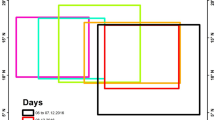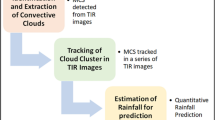Abstract
This study is focused on developing pattern recognition and image fusion techniques to trace the origins and propagation of the pre-tropical storm (pre-TS) Debby (2006) mesoscale convective systems (MCSs) and African easterly waves (AEWs) using satellite imagery. These MCSs could be generating over mountains in North Africa and going through complicated splitting and merging processes. Therefore, an objectively analyzed MCS movement is essential. This study presents a technique which traces extracted features to find the origin of TS Debby. This technique produces a fused image with the most relevant information from water vapor and infrared satellite images, segments the cloud top height satellite images by clustering clouds, and tracks clouds to determine the origin of TS Debby (2006). The presented technique could be applied to other AEWs and MCSs which lead to tropical cyclogenesis to improve the numerical weather prediction over data sparse areas, such as over eastern and central North Africa.













Similar content being viewed by others
References
Agudelo PA, Hoyos CD, Curry JA, Webster PJ (2011) Probabilistic discrimination between large-scale environments of intensifying and decaying African easterly waves. Clim Dyn 36(7):1379–1401
Albayrak S, Amasyali F (2003) Fuzzy C-means clustering on medical diagnostic systems. In: Proceedings of International XII. Turkish Symposium on Artificial Intelligence and Neural Networks. http://www.ce.yildiz.edu.tr/mygetfile.php?id=269. Accessed 1 April 2011
Burpee RW (1972) The origin and structure of easterly waves in the lower troposphere of North Africa. J Atmos Sci 29:77–90
Berry GJ, Thorncroft C (2005) Case study of an intense African easterly wave. Mon Wea Rev 133(4):752–766
Carlson TN (1969) Synoptic histories of three African disturbances that developed into Atlantic hurricanes. Mon Wea Rev 97(3):256–276
Grazzini J, Bereziat D, Herlin Z (2001) Analysis of cloudy structures evolution on meteorological satellite acquisitions. In: Proceedings 2001 International Conference on Image Processing, vol 3. pp 760–763
Grist JP (2002) Easterly waves over Africa. Part I: the seasonal cycle and contrasts between wet and dry years. Mon Wea Rev 130(2):197–211
Hall DL, McMullen SAH (2004) Mathematical techniques in multisensor data fusion, 2nd edn. Artech House, Massachussets
Hill CM, Lin Y-L (2003) Initiation of a mesoscale convective complex over the ethiopian highlands preceding the genesis of hurricane Alberto (2000). Geophys Res Lett 30(5):1232
Hodges KI, Thorncroft CD (1997) Distribution and statistics of African mesoscale convective weather systems based on the ISCCP Meteosat imagery. Mon Wea Rev 125(11):2821–2837
ITT Visual Information Solutions. Product Services. http://www.ittvis.com/language/en-US/ProductServices/IDL.aspx. Accessed 1 June 2011
Jirak IL, Cotton WR (2007) Observational analysis of the predictability of mesoscale convective systems. Wea Forecast 22(4):813–838
Lacewell CW, Gebril M, Buaba R, Homaifar A (2010) Optimization of Image fusion using genetic algorithms and discrete wavelet transform. In: Aerospace and Electronics Conference (NAECON), Proceedings of the IEEE 2010 National, pp 116–121
Laing AG, Fritsch JM (1993) Mesoscale convective complexes in Africa. Mon Wea Rev 121(8):2254–2263
Landsea CW (1993) A climatology of intense (or major) Atlantic hurricanes. Mon Wea Rev 121(6):1703–1713
Lin Y-L (2007) Mesoscale dynamics. Cambridge University Press, New York
Lin Y-L, Robertson KE, Hill CM (2005) Origin and propagation of a disturbance associated with an African easterly wave as a precursor of hurricane Alberto 2000. Mon Wea Rev 133(11):3276–3298
Lin Y-L, Liu L, Tang G, Spinks J, Jones W (2012) Origin of the pre-tropical storm Debby (2006) African easterly wave–mesoscale convective system. Meteor Atmos Phys (in review)
Mandal AK, Pal S, De AK, Mitra S (2005) Novel approach to identify good tracer clouds from a sequence of satellite images. IEEE Trans Geosci Remote Sens 43(4):813–818
MathWorks Incorporated, MATLAB The Language of Technical Computing. http://www.mathworks.com/products/matlab. Accessed 1 June 2011
Mozer JB, Zehnder JA (1996) Lee vorticity production by large-scale tropical mountain ranges. Part II: a mechanism for the production of African waves. J Atmos Sci 53(4):539–549
Mumtaz A, Majid A, Mumtaz A (2008) Genetic algorithms and its application to image fusion. In: 4th International Conference on Emerging Technologies, 2008, ICET 2008, pp 6–10
Ning J, Zhang L, Zhang D, Wu C (2010) Scale and orientation adaptive mean shift tracking. Comput Vis IET 6(1):52–61
Pielke RA, Landsea CW (1998) Normalized hurricane damages in the United States. 1925–95. Wea Forecast 13(3):621–631
Piñeros M, Ritchie EA (2006) Quantifying morphologic features of remotely-sensed data for its use in a tropical cyclogenesis predictor. http://ams.confex.com/ams/pdfpapers/108814.pdf. Accessed 20 May 2011
Piñeros MF, Ritchie EA, Tyo JS (2010) Detecting tropical cyclone genesis from remotely sensed infrared image data. IEEE Geosci Remote Sens Lett 7(4):826–830
Pytharoulis I, Thorncroft C (1995) The low-level structure of African easterly waves. Mon Wea Rev 127(10):2266–2280
Reed RJ, Norquist DC, Recker EE (1977) The structure and properties of African wave disturbances as observed during phase III of GATE. Mon Wea Rev 105(3):317–333
Simpson RH, Frank N, Shideler D, Johnson HM (1968) Atlantic tropical disturbances 1967. Mon Wea Rev 96(4):251–259
Theodoridis S, Koutroumbas K (2003) Pattern recognition, 2nd edn. Academic Press, San Diego
Wehrmann T, Colditz R, Bachman M, Steinnocher K, Dech S (2004) Evaluation of image fusion T. In: Proceedings of the 1st Göttingen GIS and Remote Sensing Days
Zawislak J, Zipser EJ (2010) Observations of seven African easterly waves in the east Atlantic during 2006. J Atmos Sci 67(1):26–43
Acknowledgments
The authors are very grateful to the anonymous reviewers for their helpful and insightful recommendations. This research was supported in part by the National Oceanic and Atmospheric Administration Educational Partnership Program under Cooperative Agreement No. NA06OAR4810187 and the Expeditions in Computing program of the National Science Foundation under Award No. CCF 1029731. The contributions to and the assistance of Kenneth R. Knapp of NOAA National Climatic Data Center to this research are greatly appreciated.
Author information
Authors and Affiliations
Corresponding author
Additional information
Responsible Editor: J.-F. Miao.
Rights and permissions
About this article
Cite this article
Lacewell, C.W., Homaifar, A. & Lin, YL. Tracing the origins and propagation of pre-tropical storm Debby (2006) mesoscale convective systems using pattern recognition and image fusion. Meteorol Atmos Phys 119, 43–58 (2013). https://doi.org/10.1007/s00703-012-0214-8
Received:
Accepted:
Published:
Issue Date:
DOI: https://doi.org/10.1007/s00703-012-0214-8




